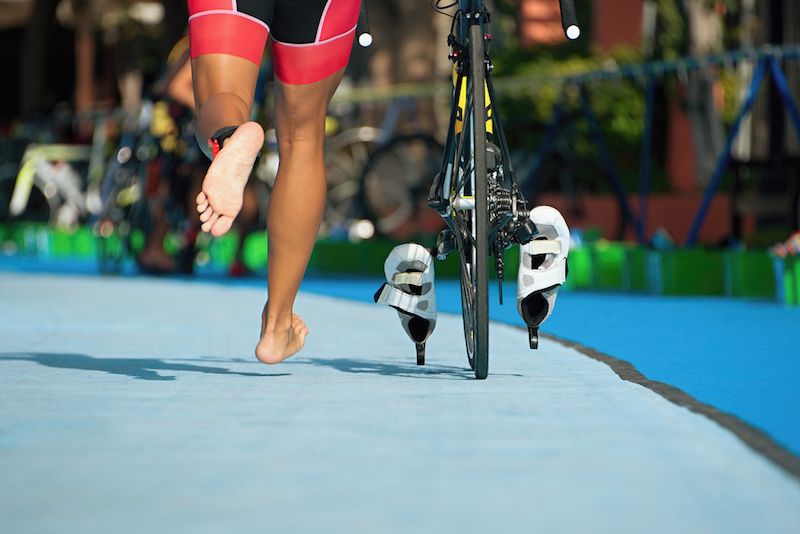Don’t Get Spooked by the Gear: Runners Can Become Triathletes

Runners who want to attempt triathlons need not worry about the gear.
In part two of a series, learn about the equipment you’ll need to try multisport events.
Missed part one? Read it here.
So, you’ve made the decision to try events that include swimming, cycling, and running. Now it’s time to consider the gear you’ll need to complete your goal.
Don’t run away, yet. Gear talk (especially for runners) can be discouraging, but you only need basic equipment and you can choose inexpensive options. The barebones checklist?
- Goggles, swim cap, swimsuit
- Bike, helmet, sunglasses
- Running shoes
But let’s get into more detail.
The Bike
The bike may seem like a challenge but you can do your first sprint triathlon on any bike (yes, really!). Maybe not a unicycle or tricycle or recumbent (as those are usually prohibited), but pretty much anything else: road bike, mountain bike, hybrid, cheap, expensive—you do not need a fancy bike.
You should, however, have a quick tune-up on any bike that’s been gathering dust for more than a year, and even a simple bike fit with a bike specialist will make your experience much better. You may want to see if you enjoy cycling before you sink a lot of money into a bike. So, use anything you have access to for training for your first event (and, of course, don’t forget a helmet).
You’ll also need a bag that attaches to your bike to carry tire tubes in case of a flat tire, and air cartridges or small pump. Learn to change a tire tube and basic bike maintenance—YouTube is a great resource and so is your local bike shop, where you can ask questions or attend educational workshops for beginners. Access to an indoor bike, a class, or bike trainer is helpful, as are padded shorts (cycling or triathlon shorts), a water bottle cage on the bike, and bottles. Wear sunglasses to protect your eyes not just from the sun, but also from road debris—and my personal nemesis, flying insects.
Training Apparel
For swimming, you need access to a lap pool that is a 25 yard minimum length, ideally—but go with what you have, goggles, a swim cap, a one-piece fitted swimsuit, and potentially a wetsuit (see below).
For the bike and the run you can train in almost any comfortable clothing. Note that wicking material will be more comfortable and less chafe-prone. Additionally, tight clothing—while not for the faint of heart—is functional for the sport. Formfitting apparel prevents chafing and drag. On the bike, especially, you can become a parachute if your top is too loose. It also wicks away sweat and moisture, just like running apparel.
You all already know what you need to run. So one-third of the drama is out of the way. How fantastic is that?
Race Day Wear
For race day you may want to purchase a triathlon suit, also known as a tri kit. If you are just dabbling to see if you like triathlon, then do a few things to keep costs down:
- Wear a swimsuit in the race with a sports bra underneath, throw on a pair of shorts for the bike, and put on a t-shirt or tank top for the run. Keep your swimsuit on the whole time.
- Wear a snug wicking tank and tri shorts for the entire race. Swim, bike, and run without changing clothes, though you can always add layers if needed. A tri suit is hassle-free and handy if you plan to continue in the sport.
The Wetsuit
If the water temperature is cold on race day, you may need a wetsuit—race officials will let you know ahead of time if the water temps are legal for wetsuit use. You’ll want to practice with a wetsuit prior to your event, if you plan to use one—many new swimmers find them restrictive, so acclimating is critical. You should have a full range of motion for your upper body.
If you’re not sure if you’ll pursue triathlon further, then research local or online outlets to rent a wetsuit instead of buying one.
In part three of this triathlon series, we’ll talk training.
Meredith Atwood (@SwimBikeMom) is a four-time Ironman, recovering attorney, motivational speaker, coach, and author of Triathlon for the Every Woman: You Can Be a Triathlete. Yes. You. She is the host of the podcast “The Same 24 Hours.” You can download a free triathlon race day checklist here. Her next book, The Year of No Nonsense, is available Fall 2019.